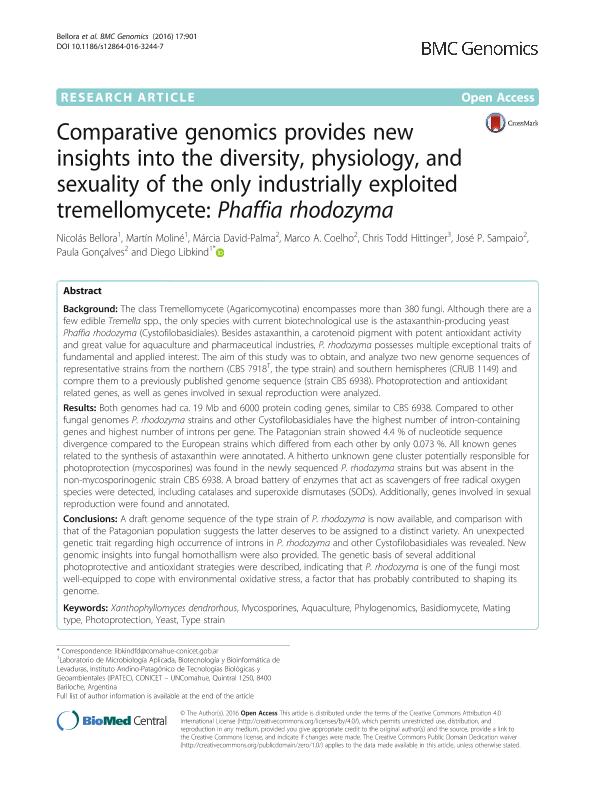Mostrar el registro sencillo del ítem
dc.contributor.author
Bellora, Nicolás

dc.contributor.author
Moline, Martin

dc.contributor.author
David Palma, Márcia
dc.contributor.author
Coelho, Marco A.
dc.contributor.author
Hittinger, Chris Todd
dc.contributor.author
Sampaio, José P.
dc.contributor.author
Gonçalves, Paula
dc.contributor.author
Libkind Frati, Diego

dc.date.available
2018-10-23T20:47:29Z
dc.date.issued
2016-11
dc.identifier.citation
Bellora, Nicolás; Moline, Martin; David Palma, Márcia; Coelho, Marco A.; Hittinger, Chris Todd; et al.; Comparative genomics provides new insights into the diversity, physiology, and sexuality of the only industrially exploited tremellomycete: Phaffia rhodozyma; BioMed Central; BMC Genomics; 17; 1; 11-2016; 1-16
dc.identifier.issn
1471-2164
dc.identifier.uri
http://hdl.handle.net/11336/62965
dc.description.abstract
Background: The class Tremellomycete (Agaricomycotina) encompasses more than 380 fungi. Although there are a few edible Tremella spp., the only species with current biotechnological use is the astaxanthin-producing yeast Phaffia rhodozyma (Cystofilobasidiales). Besides astaxanthin, a carotenoid pigment with potent antioxidant activity and great value for aquaculture and pharmaceutical industries, P. rhodozyma possesses multiple exceptional traits of fundamental and applied interest. The aim of this study was to obtain, and analyze two new genome sequences of representative strains from the northern (CBS 7918T, the type strain) and southern hemispheres (CRUB 1149) and compre them to a previously published genome sequence (strain CBS 6938). Photoprotection and antioxidant related genes, as well as genes involved in sexual reproduction were analyzed. Results: Both genomes had ca. 19Mb and 6000 protein coding genes, similar to CBS 6938. Compared to other fungal genomes P. rhodozyma strains and other Cystofilobasidiales have the highest number of intron-containing genes and highest number of introns per gene. The Patagonian strain showed 4.4% of nucleotide sequence divergence compared to the European strains which differed from each other by only 0.073%. All known genes related to the synthesis of astaxanthin were annotated. A hitherto unknown gene cluster potentially responsible for photoprotection (mycosporines) was found in the newly sequenced P. rhodozyma strains but was absent in the non-mycosporinogenic strain CBS 6938. A broad battery of enzymes that act as scavengers of free radical oxygen species were detected, including catalases and superoxide dismutases (SODs). Additionally, genes involved in sexual reproduction were found and annotated. Conclusions: A draft genome sequence of the type strain of P. rhodozyma is now available, and comparison with that of the Patagonian population suggests the latter deserves to be assigned to a distinct variety. An unexpected genetic trait regarding high occurrence of introns in P. rhodozyma and other Cystofilobasidiales was revealed. New genomic insights into fungal homothallism were also provided. The genetic basis of several additional photoprotective and antioxidant strategies were described, indicating that P. rhodozyma is one of the fungi most well-equipped to cope with environmental oxidative stress, a factor that has probably contributed to shaping its genome.
dc.format
application/pdf
dc.language.iso
eng
dc.publisher
BioMed Central

dc.rights
info:eu-repo/semantics/openAccess
dc.rights.uri
https://creativecommons.org/licenses/by-nc-sa/2.5/ar/
dc.subject
Aquaculture
dc.subject
Basidiomycete
dc.subject
Mating Type
dc.subject
Mycosporines
dc.subject
Photoprotection
dc.subject
Phylogenomics
dc.subject
Type Strain
dc.subject
Xanthophyllomyces Dendrorhous
dc.subject
Yeast
dc.subject.classification
Otras Ciencias Biológicas

dc.subject.classification
Ciencias Biológicas

dc.subject.classification
CIENCIAS NATURALES Y EXACTAS

dc.title
Comparative genomics provides new insights into the diversity, physiology, and sexuality of the only industrially exploited tremellomycete: Phaffia rhodozyma
dc.type
info:eu-repo/semantics/article
dc.type
info:ar-repo/semantics/artículo
dc.type
info:eu-repo/semantics/publishedVersion
dc.date.updated
2018-10-22T13:19:13Z
dc.journal.volume
17
dc.journal.number
1
dc.journal.pagination
1-16
dc.journal.pais
Reino Unido

dc.journal.ciudad
Londres
dc.description.fil
Fil: Bellora, Nicolás. Consejo Nacional de Investigaciones Científicas y Técnicas. Centro Científico Tecnológico Conicet - Patagonia Norte. Instituto Andino Patagónico de Tecnologías Biológicas y Geoambientales. Universidad Nacional del Comahue. Instituto Andino Patagónico de Tecnologías Biológicas y Geoambientales.; Argentina
dc.description.fil
Fil: Moline, Martin. Consejo Nacional de Investigaciones Científicas y Técnicas. Centro Científico Tecnológico Conicet - Patagonia Norte. Instituto Andino Patagónico de Tecnologías Biológicas y Geoambientales. Universidad Nacional del Comahue. Instituto Andino Patagónico de Tecnologías Biológicas y Geoambientales.; Argentina
dc.description.fil
Fil: David Palma, Márcia. Universidade Nova de Lisboa; Portugal
dc.description.fil
Fil: Coelho, Marco A.. Universidade Nova de Lisboa; Portugal
dc.description.fil
Fil: Hittinger, Chris Todd. University of Wisconsin; Estados Unidos
dc.description.fil
Fil: Sampaio, José P.. Universidade Nova de Lisboa; Portugal
dc.description.fil
Fil: Gonçalves, Paula. Universidade Nova de Lisboa; Portugal
dc.description.fil
Fil: Libkind Frati, Diego. Consejo Nacional de Investigaciones Científicas y Técnicas. Centro Científico Tecnológico Conicet - Patagonia Norte. Instituto Andino Patagónico de Tecnologías Biológicas y Geoambientales. Universidad Nacional del Comahue. Instituto Andino Patagónico de Tecnologías Biológicas y Geoambientales.; Argentina
dc.journal.title
BMC Genomics

dc.relation.alternativeid
info:eu-repo/semantics/altIdentifier/url/http://bmcgenomics.biomedcentral.com/articles/10.1186/s12864-016-3244-7
dc.relation.alternativeid
info:eu-repo/semantics/altIdentifier/doi/http://dx.doi.org/10.1186/s12864-016-3244-7
Archivos asociados
